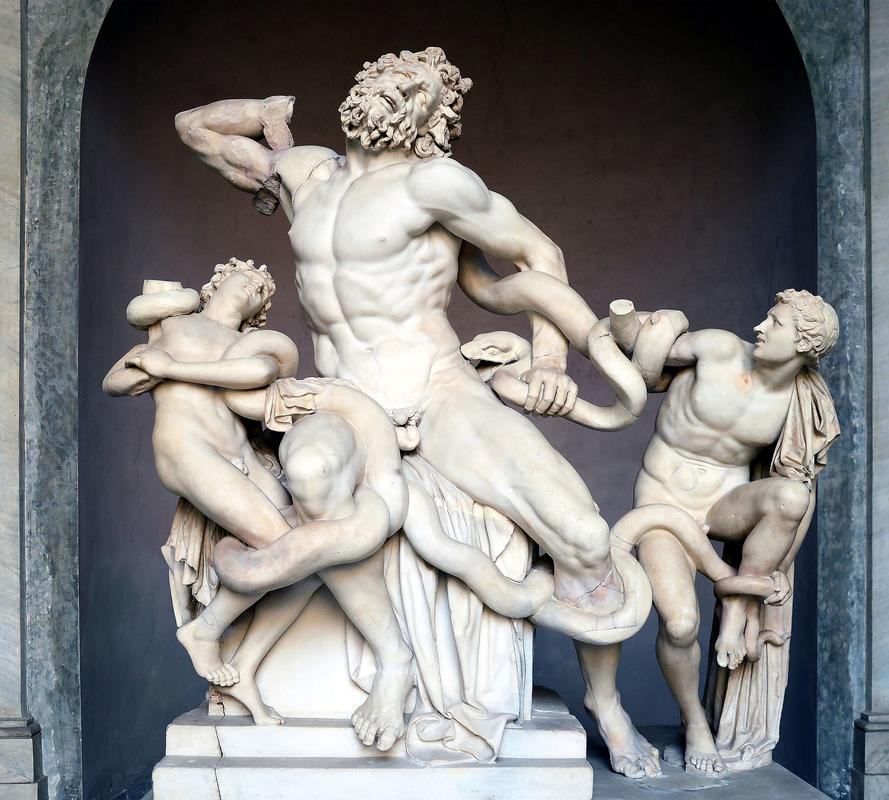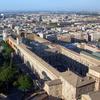More about Laocoön and His Sons

Sr. Contributor
The myth of Laocoön is as twisted as his body in Laocoön and His Sons.
It was the early 12th century and the people of Troy were at war with the Greeks. The Trojan War was in its tenth year and the Greeks were losing hope of breaking through Troy’s city walls. They decided to switch their plan of attack from force to deception. The Greeks secretly built a gigantic wooden horse, stuffed hundreds of soldiers inside, and offered it up to the Trojans as a symbol of their surrender. The Trojans must have been a bunch of horse girls because as soon as they saw the gift from the Greeks, they began to party. Laocoön, the Trojan’s chief priest of Poseidon, was the only Trojan who wasn’t convinced of the Greeks’ good intentions. As the people of Troy drank and celebrated the arrival of their new steed, Laocoön pleaded with his friends and family not to bring the wooden horse into the city walls. Laocoön was raining on the Trojans’ parade and since no one likes a party pooper, everyone dismissed his words of warning.
Laocoön decided to turn to the gods for guidance and sacrificed a bull in honor of Poseidon, along with the help of his two sons. While the men were distracted, two massive sea serpents suddenly appeared and viciously attacked the trio. The serpents started with Laocoön’s sons, each constricting and biting one boy while Laocoön helplessly watched from the sidelines. As Laocoön reached for his weapon, the serpents turned their focus onto the priest and began to wrap him tighter and righter, slowly crushing his bones and eventually squeezing out his final breath.
Sea serpents don’t just slither out of the depths and massacre a family of their own accord, so the million dollar question is: who sent the beasts? The poet Virgil claimed that it was Athena, the goddess of war, because she wanted to punish Laocoön for meddling with the Greeks’ plan. On the other hand, the Greek scholar Apollodorus wrote that Laocoön had sex with his wife in Apollo’s temple, so the sun god sought his revenge. Whoever the culprit, the outcome was the same, and without Laocoön to gripe about the Trojans, the Trojan Horse was brought into the city walls. That night, Troy was overrun with angry Greeks (no doubt annoyed at being stuck in a horse for one too many hours) and the city was sacked. A true “I told you so” moment for Laocoön - though he didn't even get to enjoy it.
In 77 C.E., Pliny the Elder, a Roman scholar, admired the Hellenistic statue group while visiting the house of Emperor Titus. He was so absorbed by Laocoön’s agony that he wrote about the artwork in his encyclopedia of all known knowledge, The Natural History, claiming the piece was superior to all others. Owning a sculpture with Pliny’s seal of approval must have been the ultimate goal for an antiquary like Pope Julius II. So, in 1506, when a farmer on Esquiline Hill excavated Laocoön and His Sons in his vineyard, Pope Julius II was more than interested in the farmer’s claim. He sent a team of antiquity aficionados, including Michelangelo, to analyze the statue before snatching it up for his own collection.
In his encyclopedia, Pliny attributed Laocoön and His Sons to the sculpting team of Athanadoros, Hagesandros, and Polydoros of Rhodes, but no signature was found on the newly unearthed statue, so the authenticity of the piece was scrutinized. As the inspection of Laocoön and His Sons continued, more discrepancies between the artwork and Pliny’s description were revealed. Pope Julius II ended up overlooking these inconsistencies and bought Laocoön and His Sons to show off in his private statue garden.
After Laocoön and His Sons arrived at the Vatican, other classical scholars joined in on the analysis of the sculpture and its provenance. One scholar proclaimed that the Vatican’s Laocoön and His Sons was a forgery made during the Renaissance by Michelangelo, while others argued that it was pillaged by Roman soldiers from Greece during the late Republic. Some art historians suspect the sculpture is a Roman copy of a much earlier Greek original, and others contend that it was commissioned by a wealthy Roman, crafted on the Greek island of Rhodes, and then transported to Italy. However, the most widely accepted origin story for this Laocoön and His Sons is simply that it was sculpted in Rome for a Roman patron between 150 B.C.E and 70 C.E.
Wherever and whenever it came from doesn’t matter much when you are standing in front of the larger-than-life statue group at the Vatican. Nearly 1950 years after Pliny was awestruck by the imposing sculpture, Laocoön and His Sons continues to captivate museum-goers from around the world and teach the invaluable life lesson to always be just as wary of sea serpents as you are of horses.
Sources
- “Book II - The Death of Laocoon.” University of Canterbury. Accessed May 15, 2022. https://www.canterbury.ac.nz/exhibition/virgil/aeneid/death-of-laocoon….
- Chaliakopoulos, Antonis. “The Man Who Almost Saved Troy: Who Was Laocoon?” The Collector, August 8, 2021. https://www.thecollector.com/who-was-laocoon-and-his-sons/.
- Herring, Amanda. “Athanadoros, Hagesandros, and Polydoros of Rhodes, Laocoön and his Sons.” Smarthistory, August 25, 2021. https://smarthistory.org/athanadoros-hagesandros-and-polydoros-of-rhode….
- “Laocoon.” Vatican Museums. Accessed May 15, 2022. https://www.museivaticani.va/content/museivaticani/en/collezioni/musei/….
Featured Content
Here is what Wikipedia says about Laocoön and His Sons
The statue of Laocoön and His Sons, also called the Laocoön Group (Italian: Gruppo del Laocoonte), has been one of the most famous ancient sculptures since it was excavated in Rome in 1506 and put on public display in the Vatican Museums, where it remains today. The statue is very likely the same one praised in the highest terms by Pliny the Elder, the main Roman writer on art, who attributed it to Greek sculptors but did not say when it was created. The figures are nearly life-sized, with the entire group measuring just over 2 m (6 ft 7 in) in height. The sculpture depicts the Trojan priest Laocoön and his sons Antiphantes and Thymbraeus being attacked by sea serpents.
The Laocoön Group has been called "the prototypical icon of human agony" in Western art. Unlike the agony often portrayed in Christian art depicting the Passion of Jesus and martyrs, the suffering here suggests neither redemption nor reward. The agony is conveyed through the contorted facial expressions, particularly Laocoön's bulging eyebrows, which were noted by Guillaume Duchenne de Boulogne as physiologically impossible. These expressions are mirrored in the struggling bodies, especially Laocoön's, with every part of his body shown straining.
Pliny attributed the work, then in the palace of Emperor Titus, to three Greek sculptors from the island of Rhodes: Agesander, Athenodoros, and Polydorus, but he did not mention the date or patron. In style it is considered "one of the finest examples of the Hellenistic baroque" and certainly in the Greek tradition. However, its origin is uncertain, as it is not known if it is an original work or a copy of an earlier bronze sculpture. Some believe it to be a copy of a work from the early Imperial period, while others think it to be an original work from the later period, continuing the Pergamene style of some two centuries earlier. Regardless, it was probably commissioned for a wealthy Roman's home, possibly from the Imperial family. The dates suggested for the statue range from 200 BC to the 70s AD, with a Julio-Claudian date (27 BC to 68 AD) now being the preferred option.
Despite being in mostly excellent condition for an excavated sculpture, the group is missing several parts and underwent several ancient modifications, as well as restorations since its excavation. The statue is currently on display in the Museo Pio-Clementino, which is part of the Vatican Museums.
Check out the full Wikipedia article about Laocoön and His Sons












